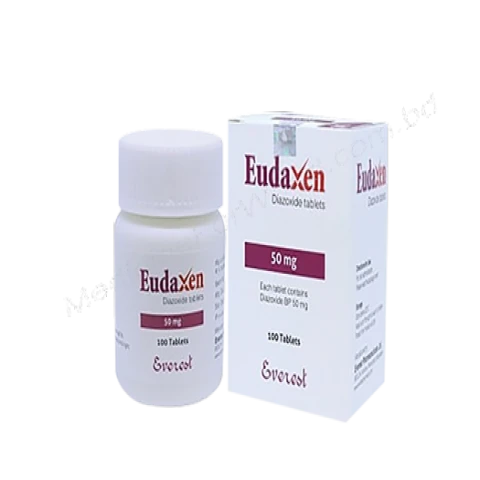Eudaxen 50 mg Tablet 100 pcs
৳ 15,000
Order By Call:
+88 01336 242 802 (Mobile)
+88 01336 242 802 (WhatsApp)
About the Product
Full Description
Indications
Eudaxen tablets are used orally in the treatment of intractable hypoglycemia.
Hypoglycaemia: Eudaxen administered orally is indicated for the treatment of intractable hypoglycaemia with severe symptoms from a variety of
causes including idiopathic hypoglycaemia in infancy, leucine-sensitive or unclassified; functional islet cell tumours both malignant and benign if
inoperable, extra-pancreatic neoplasms producing hypoglycaemia; glycogen storage disease; hypoglycaemia of unknown origin. Eudaxen also
causes salt and water retention.
Description
Eudaxen is a benzothiadiazine that is the S,S-dioxide of 2H-1,2,4-benzothiadiazine which is substituted at position 3 by a methyl group and at
position 7 by chlorine. A peripheral vasodilator, it increases the concentration of glucose in the plasma and inhibits the secretion of insulin by the
beta- cells of the pancreas. It is used orally in the management of intractable hypoglycaemia and intravenously in the management of hypertensive
emergencies. It has a role as an antihypertensive agent, a sodium channel blocker, a vasodilator agent, a K-ATP channel agonist, a beta-adrenergic
agonist, a cardiotonic drug, a bronchodilator agent, a sympathomimetic agent and a diuretic. It is a benzothiadiazine, a sulfone and an
organochlorine compound.
Pharmacology
As a diuretic, Eudaxen inhibits active chloride reabsorption at the early distal tubule via the Na-CI cotransporter, resulting in an increase in the
excretion of sodium, chloride, and water. Thiazides like Eudaxen also inhibit sodium ion transport across the renal tubular epithelium through
binding to the thiazide sensitive sodium-chloride transporter. This results in an increase in potassium excretion via the sodium-potassium
exchange mechanism. The antihypertensive mechanism of Eudaxen is less well understood although it may be mediated through its action on
carbonic anhydrases in the smooth muscle or through its action on the large-conductance calcium-activated potassium (KCa) channel, also found
in the smooth muscle. As a antihypoglycemic, Eudaxen inhibits insulin release from the pancreas, probably by opening potassium channels in the
beta cell membrane.
Pharmacodynamics: Eudaxen is a potassium channel activator. Its mechanism of action revolves around enhancing cell membrane permeability to
potassium ions. This action consequently elicits the relaxation of local smooth muscles. This switches off voltage-gated calcium ion channels which
inhibits the generation of an action potential.
Dosage & Administration
For both adults and children: a starting oral dose of 5mg/kg body weight divided into 2 or 3 equal doses per 24 hours will establish the patient's
response and thereafter the dose can be increased until the symptoms and blood glucose level respond satisfactorily. Regular determinations of
the blood glucose in the initial days of treatment are essential. The usual maintenance dose is 3-8mg/kg/day given in two or three divided doses.
Patients with renal impairment: Reduced doses may be required in patients with impaired renal function.
In children with leucine-sensitive hypoglycaemia: A dosage range of 15- 20mg/kg/day is suggested.
In adults with benign or malignant islet-cell tumours producing large quantities of insulin: High dosages of up to 1,000mg per day have been
used.
Interaction
Drugs potentiated by Eudaxen therapy include: oral diuretics, antihypertensive agents and anticoagulants. Phenytoin levels should be monitored as
increased dosage may be needed if administered concurrently with Eudaxen. The risk of hyperglycaemia may be increased by concurrent
administration of corticosteroids or oestrogen-progestogen combinations.
Contraindications
In the treatment of hypoglycaemia, Diazoxide is contraindicated in all cases which are amenable to surgery or other specific therapy.
Hypersensitivity to any component of the preparation or other thiazides
Side Effects
The adverse reactions are thrombocytopenia, pancreatitis, hypotension, diarrhea, heart failure etc.
Pregnancy & Lactation
Pregnancy: Reproduction studies using the oral preparation in rats have revealed increased fetal resorptions and delayed parturition, as well as
fetal skeletal anomalies; evidence of skeletal and cardiac teratogenic effects in rabbits has been noted with intravenous administration. The drug
has also been demonstrated to cross the placental barrier in animals and to cause degeneration of the fetal pancreatic beta cells. Since there are
no adequate data on fetal effects of this drug when given to pregnant women, safety in pregnancy has not been established. When the use of
Diazoxide is considered, the indications should be limited to those specified above for adults, and the potential benefits to the mother must be
weighed against possible harmful effects to the fetus. Diazoxide Tablets are only to be used in pregnant women when the indicated condition is
deemed to put the mother's life at risk. Prolonged oral therapy of Diazoxide during pregnancy has been reported to cause alopecia in the newborn.
Nursing mothers: Information is not available concerning the passage of Diazoxide in breast milk. Because many drugs are excreted in human milk
and because of the potential for adverse reactions from Diazoxide in nursing infants, a decision should be made whether to discontinue nursing or
to discontinue the drug, taking into account the importance of the drug to the mother.
Precautions & Warnings
In the treatment of hypoglycaemia it is necessary that the blood pressure be monitored regularly. Retention of sodium and water is likely to
necessitate therapy with an oral diuretic such as frusemide or ethacrynic acid The dosage of either of the diuretics mentioned may be up to 1g daily.
It must be appreciated that if diuretics are employed then both the hypotensive and hyperglycaemic activities of Eudaxen will be potentiated and it
is likely that the dosage of Eudaxen will require adjustment downwards. In patients with severe renal failure it is desirable to maintain, with diuretic
therapy, urinary volumes in excess of 1 litre daily. Hypokalaemia should be avoided by adequate potassium replacement.
Eudaxen should be used with caution in patients with cardiac failure or impaired cardiac reserve in whom sodium and water retention may worsen
or precipitate congestive heart failure. A direct effect on myocardium and cardiac function cannot be excluded.
Eudaxen should be used with care in patients with impaired cardiac or cerebral circulation and in patients with aortic coarctation, aortic stenosis,
arteriovenous shunt, heart failure or other cardiovascular disorders in which an increase in cardiac output could be detrimental.
Eudaxen should be administered with caution to patients with hyperuricaemia or a history of gout, and it is advisable to monitor serum uric acid
concentration.
Whenever Eudaxen is given over a prolonged period regular haematological examinations are indicated to exclude changes in white blood cell and
platelet counts.
Also in children there should be regular assessment of growth, bone and psychological maturation.
The very rapid, almost complete protein binding of Eudaxen requires cautious dosage to be used in patients whose plasma proteins may be lower
than normal
Overdose Effects
Excessive dosage of Eudaxen can result in hyperglycaemia. Severe hyperglycaemia may be corrected by giving insulin and less severe
hyperglycaemia may respond to oral hypoglycaemics. Hypotension may be managed with intravenous fluids and in severe cases may require
sympathomimetics.
Therapeutic Class
Combination Oral hypoglycemic preparations
Storage Conditions
Store below 30°C. Store in the original container in order to protect from moisture. Keep Eudaxen out of reach and sight of the children








